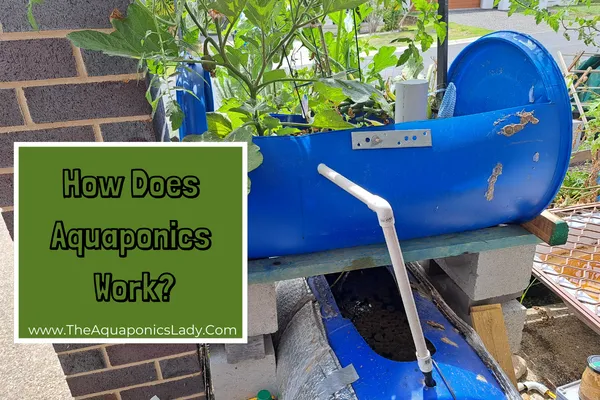
How Does Aquaponics Work? | Your Guide to Home Aquaponics Systems
How Does Aquaponics Work?
At its fundamental core, aquaponics replicates the natural freshwater ecosystem and brings it into a man-made design.
It is a sustainable form of gardening that uses fish to provide liquid fertiliser (ammonia) for the plants to use, and the plants filter the water for the fish.
There are many designs for aquaponics and systems of many sizes that we can create, from community food production aquaponics systems to mini benchtop systems.
They all have a purpose, and the key is they all have the same fundamentals to be successful. Without the fundamentals, the aquaponics system will not work for long.
The 5 Key Things to Understand About Home Aquaponics:
1. Harmonious Balanced Relationship: Aquaponics creates a closed-loop system where fish and plants coexist together, using each other. Fish waste provides fertiliser for plants, and plants filter and clean the water for the fish.
2. Fish Tanks and Veggie Growing Areas: The system design includes fish tanks where fish are kept and veggie growing areas where plants are grown. Nutrient-rich water from the fish tanks is circulated to the veggie growing areas (generally grow beds), providing nutrients for plant growth.
3. Biofiltration: Beneficial bacteria convert fish waste into fertiliser usable by plants. This process, known as biofiltration (biological filtration), involves the conversion of ammonia into nitrites and then nitrates, which serve as essential nutrients for plants.
4. Continuous Water Circulation: Water is continuously circulated from the fish tanks to the grow beds and back again using a pump system. This ensures a constant supply of water and fertiliser for both the fish and the plants.
5. Sustainability and Benefits: Aquaponics is a form of sustainable agriculture or a sustainable urban gardening method that conserves water, minimises waste, and requires no chemical fertilisers or pesticides. The many benefits aquaponics offers include higher production in a smaller space, faster plant growth, year-round production, and an activity to do with the kids to help them learn more about science and where food comes from.
Aquaponics System Size Examples: Find The Type of System That Suits You

Benchtop or Mini Aquaponics System
The basic fundamentals of aquaponics are there:
A fish tank
Filtration to convert fish waste into fertiliser.
A plant-growing area.

Indoor Aquaponics System
This is a cheap and easy aquaponics system to build, growing veggies with the waste from my freshwater turtles.
The same concept, same process, and similar types of parts are needed as the benchtop aquaponics system above. The parts used are slightly different or larger, however (bigger fish tank, different type of veggie growing area).

Courtyard Aquaponics System
Using the same aquaponic fundamentals, this system uses different parts to make it work.
Instead of a glass fish tank, the bottom barrel is a fish tank. It also has a different veggie growing area.

Backyard Aquaponics System
Again, we are getting bigger home aquaponics systems with slightly different designs and equipment.
However, the fundamentals are the same;
Fish tank
Filters
Veggie growing area
In this sized aquaponics system, there is a sump that collects all the water and pumps it back into the fish tank.
With the fundamentals staying the same, there are so many choices on the types of aquaponics systems that will work in your space and how to build them.
Get the Visual on How An Aquaponic System Works
Check out My YouTube Channel 'Candy The Aquaponics Lady'
Aquaponics is an ecosystem, and with anything it takes time to learn how it works. So, sit back and binge-watch my 'how to' playlist and the 'Water Quality Made Simple' Playlist, and learn the next steps in your aquaponics system as you create the ecosystem.
Here are the next 2 videos I recommend you watching to create your ecosystem ~ before you add any fish.
Feel free to browse my aquaponics world on YouTube.
How Aquaponics Works as an Ecosystem
How to Cycle Your Aquaponics System (How to colonise it with bacteria)
Want to get your Eyes and Hands on the FREE Online Aquaponics Essentials Course?
This is a great free aquaponics course to really understand the basics of how aquaponics works as a sustainable ecosystem. Learn the benefits of setting up a vegetable garden that will grow your organic food is a productive way.
You learn how all the 'parts' make up the 'whole', and helps to give you the foundations of understanding aquaponics.
Sign up HERE

Candy Alexander is a dedicated aquaponics enthusiast with a wealth of formal training in aquaculture. Over the past 15 years, Candy has been deeply immersed in both commercial and backyard aquaponics, honing her skills and expertise in this sustainable farming method.
Candy's passion lies in making aquaponics accessible to everyone. With a mission to simplify aquaponics, she believes that anyone can embark on this sustainable journey.
She encourages those new to aquaponics to "kick the tires" without a significant financial investment. Her guidance focuses on helping people start their aquaponics journey with small-scale systems, ensuring a low barrier to entry for newcomers.
Candy shares practical tips, step-by-step guides, and personal stories to inspire and guide readers on their aquaponics adventure. Whether you're a seasoned farmer or a curious beginner, Candy Alexander is your go-to source for simplifying aquaponics and fostering a sustainable gardening experience.